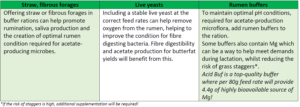Averaging at 38kg DM/ha/day, grass growth across the UK has decline 2kg on the week. Across regions, the highest growth rate at 57kg DM/ha/day was seen in Scotland, which is a drop of 8kg DM/ha/day compared to last week’s figures. The South-East has reported the lowest average growth rates at 27kg DM/ha/day, a 1 kg decreased compared to last week. The North East saw the biggest change in regional grass growth, + 14kg DM/ha/day.
Due to sunny spells and showers forecasted, it is hopeful that growth rates should improve. It will be critical to monitor sward heights to ensure optimal covers are maintaining and help optimize grazing quality and therefore animal performance. In addition to this, a flush of growth will also heighten the risk of grass staggers, where consideration to mitigate this is key for health and performance.
Potential MYFG has seen a slight increase to M+13.62 litres/day. This is 1.62litres/day greater than the figure recorded last year and is 1.11 litres/day higher than the 6-year average. Potential dry matter intakes from grass are reported to be higher, than this time last year, which may be the reason behind the slightly higher MYFG figure reported. It is worth noting that potential DMI calculations are influenced by grass sample handful weights, spoilage, and time at grass. Compared to the samples submitted this time last year, this year’s sample is much drier which reflects the dry conditions the UK has been experiencing. The North West at M+12.1 litres/day were the lowest figures recorded this week, with the North East and Yorkshire recording the highest figure of M+20.3 litres/day.
*Please take into consideration the MYFG figures, where 70% of samples were from Wales and the West. No samples were received from Scotland*.
Butterfat Factors
Acid load value was recorded at 39 and RFC recorded at 184g/kg DM respectively, which can cause a reduction in rumen pH and therefore impact the microbial population, having a subsequent effect of butterfat, promoting a depression in butterfats. See the table below for three areas which can help mitigate the risk:

Source: Trouw Nutrition GB.

